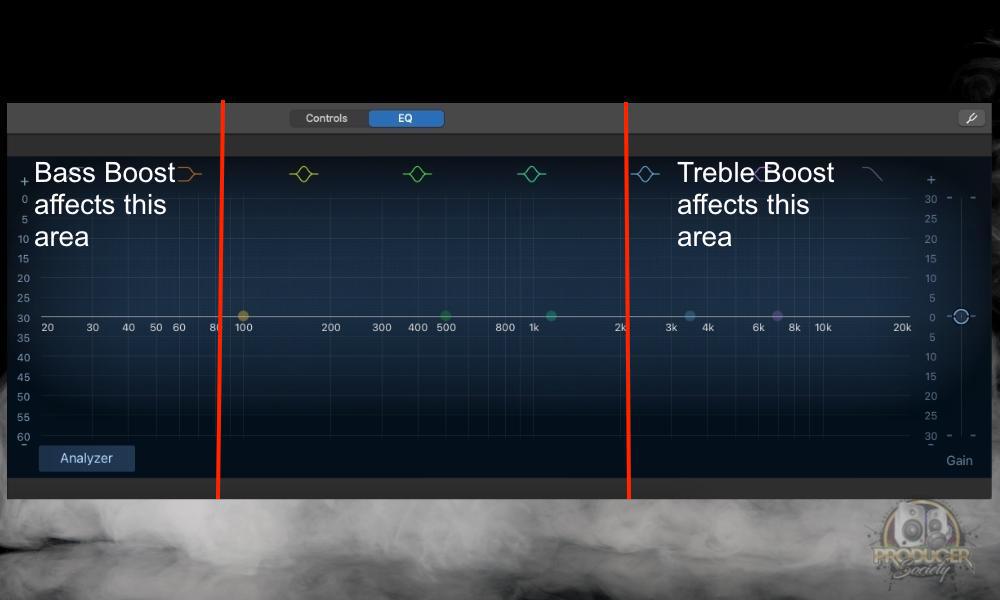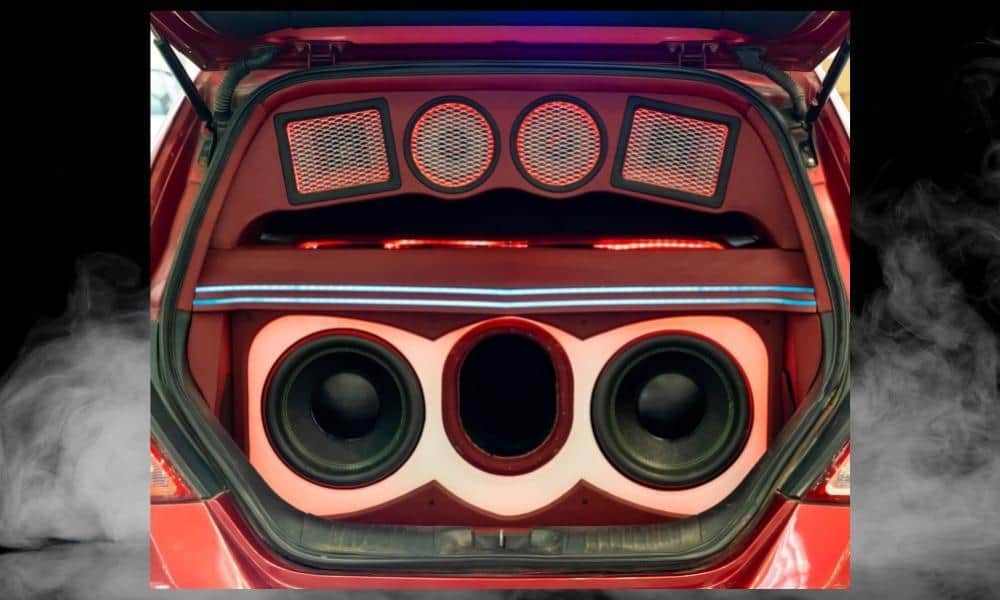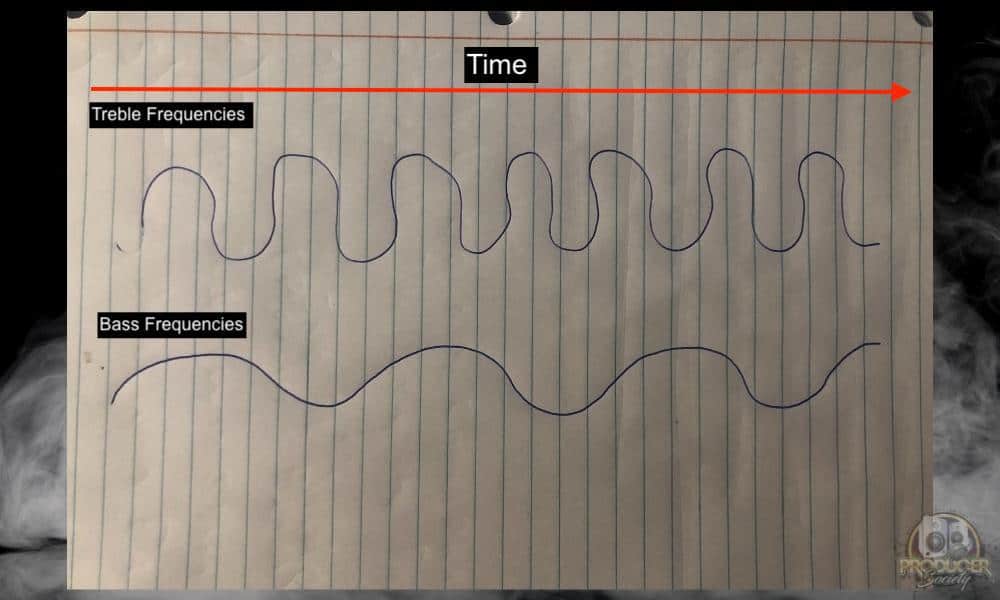Who doesn’t enjoy a bit of extra bass in their speakers? “Bass boost” is a prevalent term in music these days, and it’s generally seen as a positive among consumers when they can boost their sound system in that way, even though it may not actually result in the sound that the person wants.
Bass boosting is when you increase the amplitude or volume of the low-end frequencies of a recording. You can use either a channel EQ or a sound system’s stock equalizer to do this. Bass frequencies are typically between 50Hz and 200Hz, so this range is what you’ll aim for if you’re bass boosting.
What Happens When You Boost Bass Frequencies?
Though many consumers might have used the bass-boosting feature for their headphones or stereo systems, not everyone understands exactly what happens when they do this.

First things first, let’s talk about what actually happens when you boost bass frequencies, either in the mixing or mastering phase, in post-production, or when you’re listening to the final product on your car stereo or your iPhone headphones (my personal favorites are Etymotics ER4SRs which I got on Amazon).
1) The Lowest Frequencies Will Get Much Louder
The first thing that’ll happen when you boost the bass is that it’s going to sound a lot warmer, it’s going to increase the thumping, and it’ll also sound more powerful.
There is a certain warmth or darkness that comes from boosting the low-end. People have different words to describe it, but the video above is a good example of what happens.
As I said in my guide on how to use EQ in GarageBand, the frequency spectrum in which the human ear is capable of hearing ranges from 20Hz to 20Khz.
There are different types of sounds that can be found in different parts of that frequency range. When looking at the frequency spectrum of a recording, we tend to divide it into different bands.
The Low Frequency Band
The low band can be found between around 50Hz to 200Hz and is the region where you would find the boom and bass sounds in your recording. Above 200Hz, but less than 600Hz is where the low-mids or the more harmonic tones of the bass notes are located on the spectrum.
The Middle Frequency Band
Next is the mids, found roughly above 1000Hz but below 4000Hz. This is where the human voice is found on the frequency spectrum. It’s also where a lot of the guitar’s frequencies lie, although, the guitar certainly has some frequencies between 100Hz and 1000Hz as well.
Upper Mids to Highs
And then we reach the upper mids and highs from around 5000Hz and upwards. From roughly 2000Hz and upwards is the region referred to as treble. My piano EQ guide has a great chart you can take a look at by the way.
Simply put, when you boost the bass on a recording, you target the frequencies below 200Hz and increase their amplitude while leaving the remaining frequency bands unaffected. That means the vocals and other higher instruments will remain at the same level.
And because bass frequencies are more powerful, they tend to create actual movement in equipment, speakers, and other gear. The primary reason for this is that bass frequencies tend to travel very long distances compared to high-range frequencies.
They’re more powerful and seem to accumulate more which is why they rattle speakers. We’re going to talk a little bit more about that now.
2) Speakers Can Rattle If They Aren’t Meant For Bass

Bass boosting functionality won’t create the same effect on all speakers, because not all speakers are made equal. If you’re boosting the bass on a system with drivers that can’t push the air out of the speaker effectively, then the speakers will rattle and that’ll affect your listening experience.
Subwoofers are specialized speakers that focus specifically on sub-bass frequencies. They work well within a broader sound system because they’re specifically for playing the low-end of recordings, meaning that your other speakers are relieved of that workload.
If you’re going to listen to your music with a focus on bass boosting, then it would be a good idea to get a subwoofer for your system and set it up correctly, so that the low notes in those songs are more accurately reproduced by the subwoofers. Nowadays, it’s not just speakers that can provide you with a great bass experience, though.
Even smaller products, like Sony’s WF-XB700 wireless headphones, come factory-engineered to support more presence in the low-end of a recording (the Etymotics I mentioned earlier are still my recommendation though because I’m not into bass-boosted headphones).
3) The Bass Can Overpower or Drown Out Treble Frequencies

Having just discussed that treble frequency range from roughly 2000Hz upwards, it’s important to discuss a common effect of bass boosting on these higher frequency bands.
Not every song is going to sound good when you try to boost the bass. Sometimes, an attempt to bass boost can result in an unbalanced and muddy sound in which you can barely hear the vocals or any other mid to higher-frequency sounds. This can sound pretty bad.
Typically, the mixing engineer has analyzed the frequency spectrum of the recording to ensure that a well-balanced recording, in which no bands are competing, is produced. Changing the low frequencies means changing the picture that the mixing engineer created.
Bass sounds also have longer wavelengths than treble frequencies, and can therefore travel further and are more powerful. So increasing the amplitude of already powerful frequencies that sustain for longer than treble frequencies, drowns out the treble.
Picture this: You’re at home, and there’s a loud vibration coming from outside. Only moments after the vibration, can you actually make out the lyrics and melody of the song that’s playing. It’s the teenager’s car with the immense sound system – it’s the bass.
Now, of course, mixing and the amount of bass in a song is often a matter of taste. So, while bass boosting can sometimes help a song sound better to you, on other occasions it can totally throw off a well-balanced mix.
Kind of unrelated, but this is one reason why I like the Etymotics that I recommended to you earlier. These are headphones that aim to be balanced or frequency-neutral, so I find that I get a more accurate representation of how my music will sound on other stereo systems.
I’m not saying that I’m an audio engineer or even a great producer, but I’ve noticed that my mixes actually seem to convert pretty well to car stereos and other sound systems without even trying super hard. I think my choice of headphones is a part of the reason for this.
4) You Can Connect Better To The Rhythm of The Song (Allegedly)
![EDM Festival - What Happens When You Boost Bass [ANSWERED]](https://producersociety.com/wp-content/uploads/2022/03/EDM-Festival-What-Happens-When-You-Boost-Bass-ANSWERED-.jpg)
This one’s a bit of a stretch, but I think it’s worth talking about. Picture being at an EDM festival – the beating of your heart seems to be in sync with the rhythm of the song you’re dancing to. The bass is pulsating and you can’t help but move your body in response.
There’s something about bass. Even studies like this one in the PNAS Journal and Redditors say the same thing. The study apparently found that although the neurons in our brains synchronize to any rhythm that we hear, it is lower frequencies that are the best at helping our brain lock onto the rhythm of the song.
This might partially explain why certain dance songs just feel and sound better the more we are able to perceive and dance to the bass – whether it be the kick drum or powerful sub-bass. It could be that the increased bass connects better with the neurons in our brains.
5) You Are Accentuating The Frequency Range That Humans Seem To Prefer
![Everyone Likes Bass - What Happens When You Boost Bass [ANSWERED]](https://producersociety.com/wp-content/uploads/2022/03/Everyone-Likes-Bass-What-Happens-When-You-Boost-Bass-ANSWERED.jpg)
A study in the Journal of Perceptual and Motor Skills found that of 205 subjects, all 205 chose a frequency range revolving around 400Hz when given the ability to use a control knob to choose which sounds were most pleasurable to them.
It’s clear that there’s something about bass and lower mid frequencies that appeals more to us, and that’s why we seem to lean towards music that’s got a lot of presence in those areas. Moreover, I believe it’s easy for us to hear this range, and also a lot of instruments have frequencies there as well.
This is one part of the reason why engineers and producers commonly recommend attenuating the 200Hz range – which is known as the “muddiness” range.
Important Things to Note About Bass Boosts
1) Too Much Bass Can Damage Your Hearing
Like I pointed out in my article on hearing loss and production, it is possible to damage your hearing without feeling any discomfort when listening to low bass tones at considerable volume levels.
Although sounds below 20Hz might be more or less imperceptible to most people – they still resonate with the inner ear organ and cause damage.

 Written By :
Written By :